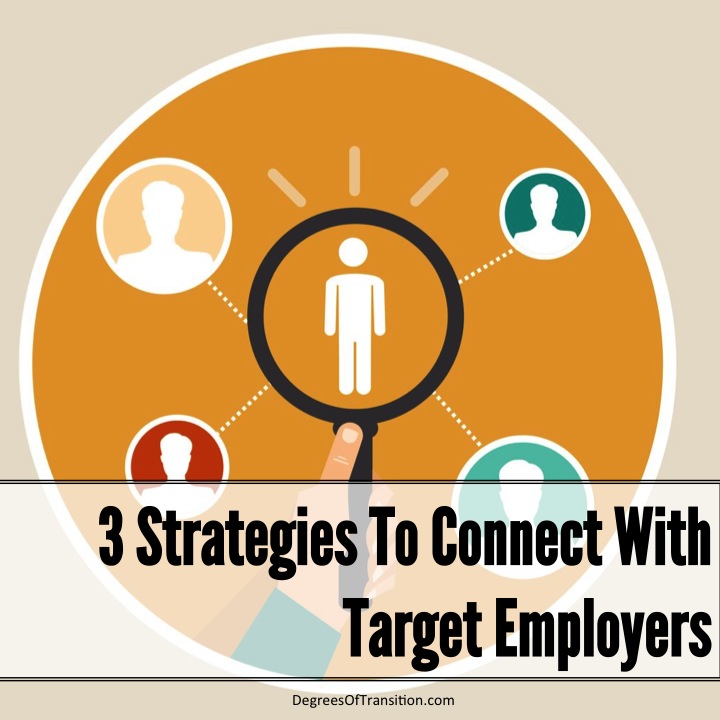If you’ve read any of my articles, or heard me speak, you know one of the job-search concepts I’m passionate about is one I like to call “Stop Applying, Start Targeting.”
Let me clarify the difference.
Applying is a transaction.
Applying is filling out all the forms and sending your information into the black hole of the job application process, and most likely, “never hearing back.”
If you have ever cried in the process of your job search, you are probably applying, and not targeting.
Applying gives you very little control and even less leverage in your job search.
Targeting on the other hand is a strategy.
Targeting means you’ve identified who you are, what you’re good at, what kind of problems you can solve for what kind of employers who need the help you have to offer. Then, you’ve identified where those employers are in the universe and you go after them.

Targeting gives you far more control in your job search.
It gives you a much more structured approach to finding your dream job.
It allows you to get into the talent funnel before job requisitions are actually posted. And it gives you a lot more confidence about the direction of your job search.
.
.
When you have a targeted job-search strategy, you are far less likely to fall down and cry in frustration “The job search is so difficult! I never hear back!”
.
Read more: 5 reasons to target your desired employers
.
You’ve targeted. Now what?
.
Let’s say you’ve mastered all this, and you have a very clear list of 20 to 25 target employers.
.
You may have more, you may have fewer.
.
Rebecca, a recent client now employed in her dream job, had a list of 44 target employers. She organized them into A, B and C priority groups so she could focus her energy on her highest value prospects. You can have as much fun with this process as you want, so do what works for you! ; )
.
Your goal is to start making contacts in the target organization and build relationships there. In the process, learn everything you can about the employer. Figure out what business problems they have that you can help solve.
.
This will make your marketing actitivies far more targeted, and successful.
.
In a recent presentation I heard a recruiter say the best way to be hired into an organization, is to be visible and in the talent funnel BEFORE the requisition is even posted.
.
That jives with my experience. As a hiring manager, I always had people in our succession plan in the event a team member left, or we were growing staff. Some were in the company. Some were not. But we always had a list. Your mission is to get on that list for an ideal employer.
.
Can you see how this can give you a tremendous competitive advantage over simply “applying on line and waiting to hear back?”
.
.
3 Actions Once You’ve Targeted Employers
.
I want to give you 3 solid strategies for connecting into your target employers so that you can start building relationships and increase your chances of being identified as the most qualified candidate.
.
Your goal is to have relationships and build visibility in that organization, and be in the talent funnel before the job requisition is ever posted.
.
1. Connect with people inside your target employer organizations.
.
Jenna applied online got a job at an organization. Six months later she absolutely hated it. She called me and wanted to know how soon she could leave without it “looking bad.”
.
She found herself in that situation because she did no research on what it would actually be like to work there. That’s another downside of applying, by the way.
.
If you want to increase your chances of not only finding a job you love, but an organization you actually like working at, do the research on your target employers.
.
Targeting employers doesn’t just help you get a job, it helps you make a much better decision about what job to take.
.
Making connections and asking them about what it’s really like to work there is one of the best job-search tools you can equip yourself with.
.
Here are three ways you can do that.
.
Ask your friends and family whom they know in these organizations.
.
This is your closest and most reliable network. Use it!
.
If you’re comfortable talking about your job search publicly, a simple note on your Facebook page might elicit many positive responses that could be helpful.
.
If you have an online portfolio or personal web site (go here for more on how to do that), you could post a personal message or video there, and link people to it.
.
If you want to be discreet, send a personal e-mail to individuals you know who might have contacts in those organizations. My client Carson sent an email last week to his circle of friends and family. The letter clearly spelled out what he did, what he was good at, and what kind of employer he was looking for.
.
The feedback he’s gotten has been phenomenal! Lots of positive comments, suggestions and leads to follow up on. Can you imagine how powerful that would be in your own job search!
.
Now make sure you read this part, because it’s super-important!
.
===> You are not asking them to get you a job! <===
.
Let me repeat that. You are not saying, “Hey, I’m looking for a job. Does anyone know of any jobs out there?” When I get an email, or god forbid – see a LinkedIn post with that sentiment, I’m on the delete key.
.
Why? How can people possibly help you with a request like that? It’s a lazy request and feels like you’re putting the burden of your job search on them. No one wants that burden.
.
If you want people to help you, be very specific about what they can do to help you. It makes it easier to say yes.
.
What you ARE telling them is that you’re investigating a new career path, that you’ve identified a number of employers that you think you could really be a good match. You share the specifics of what you are good at, and the details of the ideal employer you are looking for.
.
You ask who they know in the organization – or types of employers you are investigating – so that you can have conversations about what it’s really like to work there, and how you can help that organization be more successful.
.
This will allow you to determine if the employer should stay on your targeted employer list.
.
Look for current employees on LinkedIn, see where you have mutual connections.

.
Current employees of your target employers are a great way to learn more about your target companies. Request connections through people who are connected to them.
.
You’ll find more 2nd level connections on LinkedIn when your own network is a respectable size. If you don’t have at least 250 connections, you have some work to do!
.
If you’re just getting started on LinkedIn and not sure what I mean, read this post.
.
When you’re ready to request introductions, this post gives you step-by-step instructions. Focus on the step where you develop the message. Again, being absolutely specific in your message makes it easier for people to say YES to you.
.
Your end goal is to get introductions to hiring managers who would love to have you in their line of sight next time they are ready to hire.
.
Read more: 7 ways to beat the “you don’t have experience” objection.
.
Connect with past employees.
.
Similar to the step above, look for employees who previously worked for your target organizations. These folks are often great job search resources.
.
They can give you a “no holds barred” look at the organization, what their experience was there, and why they left. They can also give you inside intelligence on what the organization is struggling with, and how you might be able to help them.
.
Search LinkedIn for past employees who might be able to help you .
.
Read more: How to ask for LinkedIn recommendations
.
2. Request informational interviews with those people.
.
Ok, so now you have all these connections; what to do with them?
.
Start with a good informational interview strategy. I wrote an in-depth piece on informational interviews here. It’s a good read, and it will really help you.
.
From identifying the people, to making the request, setting the appointment, reconfirming, developing an agenda, managing your meeting (or call) and being clear about your “asks,” I cover it all.
.
Conducting a professional, well-executed informational interview gets you helpful information. If it’s well done, it can help you create a memorable, professional and positive impression that will keep you top of mind when that person is asked if they “know anyone who might be good for this position.”
.
Also, remember that the percent of jobs placed by referral has been estimated to be as high as 80%. Your informational interview strategy gets you information. Double bonus: It is also a stealth strategy is a to get you referred.
.
3. Leverage Social Media.
.
Here some stats I shared in a previous post:
- Recruiters search social: 92% of recruiters currently use, or plan to use social media for recruiting.
- Millennials search social: 73% of 18-34 year olds found their latest job via a social network.
- LinkedIn leads social: 94% of recruiters are active on LinkedIn, but only 36% of candidates are.
- LinkedIn again: 89% of all recruiters report having hired someone through LinkedIn. Facebook and Twitter trailed by a wide margin, reaching only 26% and 15% respectively.
.
(Sources: Jobvite Survey and Herd Wisdom)
.
I’ve seen many clients have great success with social media strategies to develop target employer relationships. Here are a couple of key success actions they took.
.
Oh, before you read this, I’m assuming you cleaned up your social media profiles and have a professional presence that’s acceptable for communicating with potential employers. : )
.
Read more: 5 easy steps to write a cover letter
.
.
LinkedIn is probably the lowest common connection denominator among across all industries. Whether it’s an old school organization or a new age digital start-up, they are most likely on LinkedIn.
.
At the very least you should have a visible LinkedIn presence, connect with people in the organization, follow their company pages, comment on their posts, and share the information that they post with your audience as well.
.
Join groups where your target employers hang out. Join in on the conversation, ask good questions, and compliment others on their sharing.
.
If there are executives who are thought leaders, follow them as well. Check out my post on 17 Ways to Use Social Media in Your Job Search also.
.
Even though it’s virtual, you can build relationships on LinkedIn and all your social media channels.
.
Twitter is loaded with recruiters, HR experts, talent acquisition managers, and all kinds of other good people you may want to know.
.
Start by identifying which of your target employers has a presence of any kind on Twitter.
.
Look for the company, specific individuals within the company, executives within the company, or any other departments that might be on Twitter. Follow them!
.
Create a Twitter list for each target company so that you can easily breeze through the feeds, retweet, comment, and connect with people there.
.
I’ve had a number of clients connect with community managers, HR people, and hiring managers who have facilitated introductions into the company.
.
.
.
Although most employers do not use Facebook to recruit, most job seekers do. This recent article gives tactics for how Facebook can help your job search.
.
Instagram/Snapchat/Pinterest
.
If you’re in the creative space for the digital creative space, you want to get the attention of employers, then the best strategy you have to speak to them in the ecosystem in which they work.
.
Tools like Instagram, Snapchat and Pinterest all lend themselves to the creative, digital space.
.
Here’s a great summary of how you can connect with employers and market yourself on Pinterest.
..
And here are some tips for Instagram.
.
Overwhelmed? Don’t be. You don’t need to do everything on this list. Just do the things that make the most sense for your job search goals, and for attracting your target employer.
.
When you take action that’s deliberate, focused and controlled, you have a much more meaningful, and successful job search.
.




1 comment